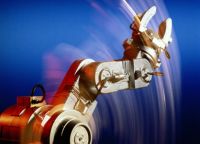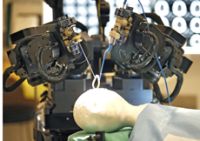Future Uses in Robotic Surgeries
The future will be full of examples of haptic feedback used in conjunction with robotic surgeries. Reviews of robotic surgeries almost always mention that haptic feedback will be a big improvement and an important next step. Many of the issues of implementing haptic feedback into surgical robots are currently being worked on and solutions are just a matter of time.The addition of haptics to the da Vinci Surgical System has received a lot of attention. This is due to the enormous success it has had in urological and other laparoscopic surgeries. The University of Nebraska Medical Center is currently working on providing feedback of grip force and speed of the surgical instruments in the da Vinci Surgical System. Currently the steep price of the da Vinci Surgical System has kept it from being in every operating room in the US, with the price of haptics only adding to this cost. After haptic feedback is added to the da Vinci Surgical System capabilites, the next drive will be to reduce the total cost of the system.
The neuroArm being developed by the University of Calgary will result in a haptic platform capable of performing neurosurgical procedures. The neuroArm system has a robot, controller and computer workstation. The workstation provides visual, auditory and haptic feedback which creates an immersive environment for the surgeon. The surgeon will control the device using a master-slave controller. The system will consist of two arms each with 7 degrees of freedom and multiple tools that can be attached. The end effectors of each arm is equipped with a multiaxis force sensor that is used to provide haptic feedback to the surgeon. The multiple degrees of freedom and space constraints of the tools increases the complexity of these multiaxis force sensors and will be a hurdle if haptic feedback is to be used in these robotic systems.
 The neuroArm from University of Calgary |
 neuroArm used on an artificial patient |